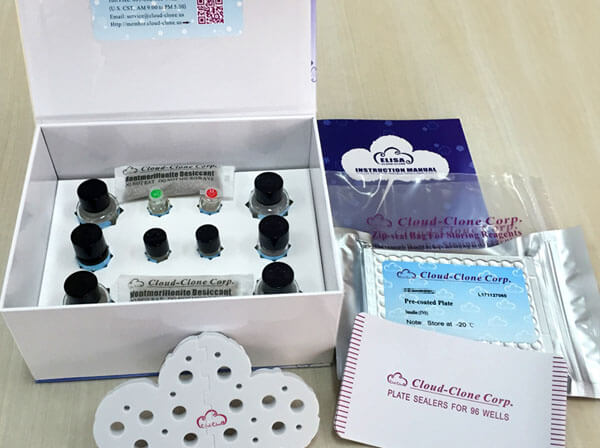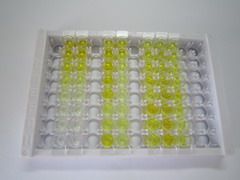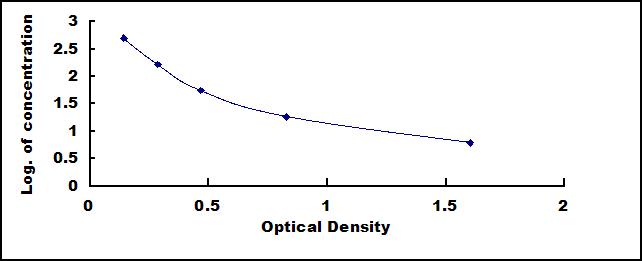ELISA Kit for Somatostatin (SST) 

GHIH; SRIF; SMST; GHRIH; GHRIF; Growth Hormone Releasing Inhibiting Hormone; Somatotropin Release-Inhibiting Factor; Somatostatin-14; Somatostatin-28
- UOM
- FOB US$ 479.00 US$ 684.00 US$ 3,078.00 US$ 5,814.00 US$ 47,880.00
- Quantity
Overview
Properties
- Product No.CEA592Ra
- Organism SpeciesRattus norvegicus (Rat) Same name, Different species.
- ApplicationsEnzyme-linked immunosorbent assay for Antigen Detection.
Research use only - DownloadInstruction Manual
- CategoryTumor immunityEndocrinologyHormone metabolism
Sign into your account
Share a new citation as an author
Upload your experimental result
Review

Contact us
Please fill in the blank.
Recovery
Matrices listed below were spiked with certain level of recombinant Somatostatin (SST) and the recovery rates were calculated by comparing the measured value to the expected amount of Somatostatin (SST) in samples.
| Matrix | Recovery range (%) | Average(%) |
| serum(n=5) | 78-95 | 88 |
| EDTA plasma(n=5) | 98-105 | 101 |
| heparin plasma(n=5) | 94-102 | 98 |
Precision
Intra-assay Precision (Precision within an assay): 3 samples with low, middle and high level Somatostatin (SST) were tested 20 times on one plate, respectively.
Inter-assay Precision (Precision between assays): 3 samples with low, middle and high level Somatostatin (SST) were tested on 3 different plates, 8 replicates in each plate.
CV(%) = SD/meanX100
Intra-Assay: CV<10%
Inter-Assay: CV<12%
Linearity
The linearity of the kit was assayed by testing samples spiked with appropriate concentration of Somatostatin (SST) and their serial dilutions. The results were demonstrated by the percentage of calculated concentration to the expected.
| Sample | 1:2 | 1:4 | 1:8 | 1:16 |
| serum(n=5) | 79-99% | 78-94% | 84-99% | 87-101% |
| EDTA plasma(n=5) | 97-105% | 87-96% | 81-93% | 78-99% |
| heparin plasma(n=5) | 90-105% | 81-90% | 86-101% | 87-101% |
Stability
The stability of kit is determined by the loss rate of activity. The loss rate of this kit is less than 5% within the expiration date under appropriate storage condition.
To minimize extra influence on the performance, operation procedures and lab conditions, especially room temperature, air humidity, incubator temperature should be strictly controlled. It is also strongly suggested that the whole assay is performed by the same operator from the beginning to the end.
Reagents and materials provided
| Reagents | Quantity | Reagents | Quantity |
| Pre-coated, ready to use 96-well strip plate | 1 | Plate sealer for 96 wells | 4 |
| Standard | 2 | Standard Diluent | 1×20mL |
| Detection Reagent A | 1×120µL | Assay Diluent A | 1×12mL |
| Detection Reagent B | 1×120µL | Assay Diluent B | 1×12mL |
| TMB Substrate | 1×9mL | Stop Solution | 1×6mL |
| Wash Buffer (30 × concentrate) | 1×20mL | Instruction manual | 1 |
Assay procedure summary
1. Prepare all reagents, samples and standards;
2. Add 50µL standard or sample to each well.
And then add 50µL prepared Detection Reagent A immediately.
Shake and mix. Incubate 1 hour at 37°C;
3. Aspirate and wash 3 times;
4. Add 100µL prepared Detection Reagent B. Incubate 30 minutes at 37°C;
5. Aspirate and wash 5 times;
6. Add 90µL Substrate Solution. Incubate 10-20 minutes at 37°C;
7. Add 50µL Stop Solution. Read at 450 nm immediately.

Test principle
This assay employs the competitive inhibition enzyme immunoassay technique. A monoclonal antibody specific to Somatostatin (SST) has been pre-coated onto a microplate. A competitive inhibition reaction is launched between biotin labeled Somatostatin (SST) and unlabeled Somatostatin (SST) (Standards or samples) with the pre-coated antibody specific to Somatostatin (SST). After incubation the unbound conjugate is washed off. Next, avidin conjugated to Horseradish Peroxidase (HRP) is added to each microplate well and incubated. The amount of bound HRP conjugate is reverse proportional to the concentration of Somatostatin (SST) in the sample. After addition of the substrate solution, the intensity of color developed is reverse proportional to the concentration of Somatostatin (SST) in the sample.
Giveaways
Increment services
Citations
- Pancreatic Somatostatinoma Diagnosed Preoperatively: Report of a CasePubmed: 24413789
- Circadian Modulation of Anxiety: A Role for Somatostatin in the AmygdalaPubmed: 24376834
- Enhanced expression of neuropeptide S (NPS) receptor in eosinophils from severe asthmatics and subjects with total IgE above 100IU/mlPubmed:24239856
- Inhibitory effect of somatostatin on insulin secretion is not mediated via the CNSPubmed:25630331
- Oral curcumin has anti-arthritic efficacy through somatostatin generationPubMed: 25836921
- Aberrant changes of somatostatin and neuropeptide Y in brain of a genetic rat model for epilepsy: tremor ratpubmed:27685769
- Positive enhancement of Lactobacillus fermentum HY01 on intestinal movements of mice having constipation10.1007/s13765-017-0327-3
- Colonic Transit Time and Gut Peptides in Adult Patients with Slow and Normal Colonic Transit Constipationpubmed:29082242
- Somatostatin Maintains Permeability and Integrity of Blood-Brain Barrier in β-Amyloid Induced ToxicityPubmed:29700775
- Home-Based Transcutaneous Neuromodulation Improved Constipation via Modulating Gastrointestinal Hormones and Bile AcidsPubmed:29853946
- Relationship between somatostatin and interleukin-6: A cross-sectional study in patients with acute pancreatitisPubmed: 30279074
- Zika Virus Infection in Hypothalamus Causes Hormone Deficiencies and Leads to Irreversible Growth Delay and Memory Impairment in MicePubmed: 30404008
- Protective Effect of Silkworm Pupa Oil on Hydrochloric Acid/Ethanol‐Induced Gastric UlcerPubmed: 30479041

















